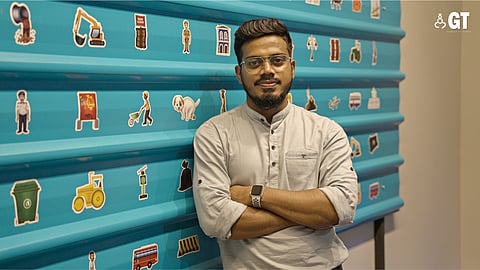

BY FR CARLOS LUIS SAC
Recently, Dattaraj Naik, a multidisciplinary visual artist and art educator based in Goa, was spotted with Tim Cook, the CEO of Apple Inc, discussing how digital tools have become an extension of us to help create more.
Tim Cook not only appreciated the artwork but also congratulated Dattaraj for making use of a digital tool (iPad) to create his mural.
At In Between, an exhibition at Sunaparanta by Sunaparanta Art Initiator Lab (SAIL) mentees, Dattaraj is exhibiting his artwork called Diversion (beta).
In it, he makes use of digital media, which has made us virtual citizens, to communicate with the youth and help them recognise the social, political and environmental issues so that they can bring about change and make this world a better place.
Tim Cook not only appreciated the artwork but also congratulated Dattaraj for making use of a digital tool (iPad) to create his mural.
Dattaraj Naik, an applied art graduate from Goa College of Art, Panjim, and a postgraduate from Maharaja SayajiRao University, Baroda, Gujarat, works as an assistant professor at Goa College of Art, Alto-Panjim.
Before his teaching career, he worked as a designer and an illustrator for a Delhi-based studio named Guerrilla Art & Design and simultaneously did street art projects with St+art India Foundation, New Delhi.
“Through the medium of art and, especially street art, we can communicate with people without any direct interaction and also, spread awareness about various topics which are not given importance in mainstream media.”
Dattaraj Naik
He is a keen observer of nature, folk culture and everyday life, which he explicitly utilises to create exaggerated characters and compositions, narrating stories and facts wittily and sarcastically.
His artistic work focuses mostly on developing practical visual languages for communication.
He says, “I choose my medium according to the idea and concept. I don’t like to restrict myself from trying new mediums apart from murals and digital art. At present, creating interactive video games is my favourite.”
Despite his busy schedule, Dattaraj is determined to meet the deadlines of his projects.
He says he is an early bird and adds, “I get about 2-3 hours to work on my personal projects before going to my regular teaching job. I like to start with my work at dawn as I feel very active during the early hours. But sometimes it depends on the deadlines of the projects.”
He strongly believes in coexisting peacefully with nature and contributing immensely to society. Therefore, as a street artist, most of his projects are displayed in public places.
Speaking of Kannagimojis his mural painted at Kannagi Art District, Kannagi Nagar, Chennai, he says, “This quirky work showcases hyperlocal and Kannagi-specific emojis that represent the visual culture embedded in the community. The seed for this mural was sown during the pandemic when we relied on technology to express our emotions. With this distinct mural, I seek to spread joy and bridge barriers at Kannagi. The work has been created as part of the third edition of Kannagi Art District for which St+Art India Foundation collaborated with Asian Paints to interpret one central theme, 'People and Environment'.”
Saath Saath is another community-based mural project of his executed at Lodhi Art District at Lodhi Colony, New Delhi, in collaboration with St+art India Foundation. Saath Saath (Together), a wall painted with the residents of Lodhi Colony, over 4 weekends in February 2019, in an open workshop format.
Prakriti aur Hum (Nature and Us) is another mural painted on a school building in Kanpur, UP. The mural he says “aims to make us ponder over the current hazards in the environment and how we can play a role in solving them. It is a witty artwork that seeks to educate the audience by portraying local animals and plants coming together like a puzzle that we must rebuild together.”
For Dattaraj, art is an experience which can move one to change or improve things around. He convincingly states, “Through the medium of art and, especially street art, we can communicate with people without any direct interaction and also, spread awareness about various topics which are not given importance in mainstream media.”
Dattaraj uses his iPad to design murals, stating, “An iPad or any other digital tool can make the process of making artwork easier. The iPad lets me design a mural digitally first and check how it is going to look in reality using various productive apps. If I feel like making any changes to the design, I can easily do it on a digital tablet, and that saves a lot of time.”
He observes that at present Goa has limited resources in terms of digital technologies related to art and that the art field is hardly given any importance. Therefore, it is rarely chosen as a career option, and because of this, we have to rely on artists and other resources from outside.
Other than art, Dattaraj is passionate about playing soccer, surfing and trekking.
He is also a tech enthusiast who loves environmentally sustainable technology. He is inspired by the work of three great artists: Banksy, a pseudonymous artist based in England; Daku, a Delhi-based graffiti artist; and Tyler, the artist behind Mumbai’s viral graffiti.
Dattaraj very humbly, despite achieving great success as an artist, suggests to young artists, “Believe in yourself and think big. Be a good human and you will become a great artist. Be humble, kind and grateful to people and things that surround you. Keep exploring, but stick to your roots!”
He excitedly looks forward to sharing with us his long-awaited mural project which aims to beautify a wall and educate children. We can’t wait to see the magic he is going to create.
(Carlos Luis is a priest belonging to the Society of the Catholic Apostolate (Pallottine) and is currently studying for a licentiate degree in Moral Theology. He comments on social and moral issues.)